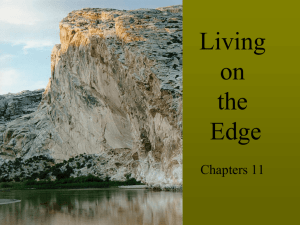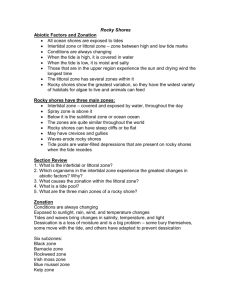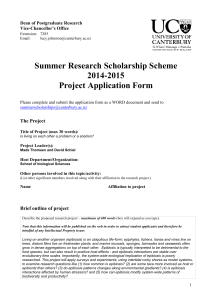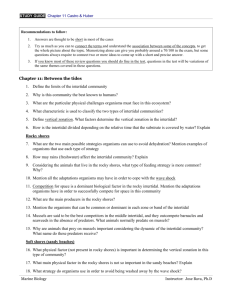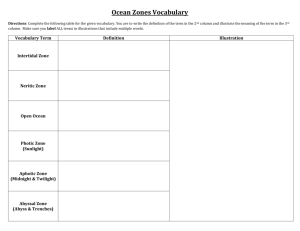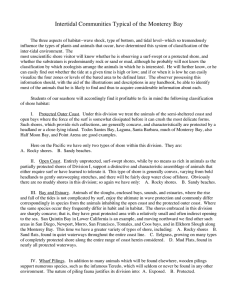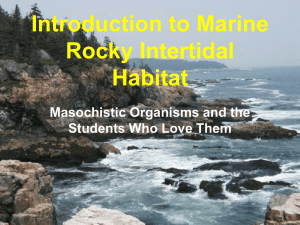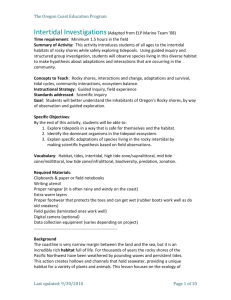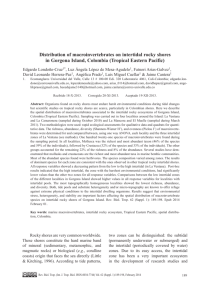Intertidal Adaptations: a qualitative description of life between tides
advertisement
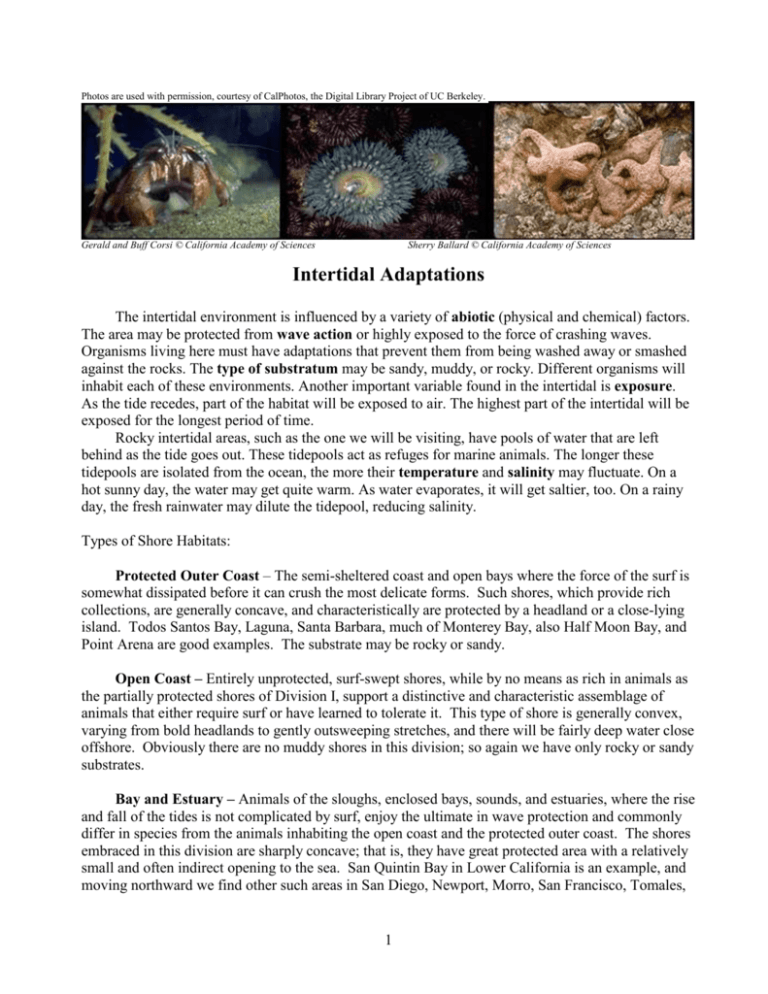
Photos are used with permission, courtesy of CalPhotos, the Digital Library Project of UC Berkeley. Gerald and Buff Corsi © California Academy of Sciences Sherry Ballard © California Academy of Sciences Intertidal Adaptations The intertidal environment is influenced by a variety of abiotic (physical and chemical) factors. The area may be protected from wave action or highly exposed to the force of crashing waves. Organisms living here must have adaptations that prevent them from being washed away or smashed against the rocks. The type of substratum may be sandy, muddy, or rocky. Different organisms will inhabit each of these environments. Another important variable found in the intertidal is exposure. As the tide recedes, part of the habitat will be exposed to air. The highest part of the intertidal will be exposed for the longest period of time. Rocky intertidal areas, such as the one we will be visiting, have pools of water that are left behind as the tide goes out. These tidepools act as refuges for marine animals. The longer these tidepools are isolated from the ocean, the more their temperature and salinity may fluctuate. On a hot sunny day, the water may get quite warm. As water evaporates, it will get saltier, too. On a rainy day, the fresh rainwater may dilute the tidepool, reducing salinity. Types of Shore Habitats: Protected Outer Coast – The semi-sheltered coast and open bays where the force of the surf is somewhat dissipated before it can crush the most delicate forms. Such shores, which provide rich collections, are generally concave, and characteristically are protected by a headland or a close-lying island. Todos Santos Bay, Laguna, Santa Barbara, much of Monterey Bay, also Half Moon Bay, and Point Arena are good examples. The substrate may be rocky or sandy. Open Coast – Entirely unprotected, surf-swept shores, while by no means as rich in animals as the partially protected shores of Division I, support a distinctive and characteristic assemblage of animals that either require surf or have learned to tolerate it. This type of shore is generally convex, varying from bold headlands to gently outsweeping stretches, and there will be fairly deep water close offshore. Obviously there are no muddy shores in this division; so again we have only rocky or sandy substrates. Bay and Estuary – Animals of the sloughs, enclosed bays, sounds, and estuaries, where the rise and fall of the tides is not complicated by surf, enjoy the ultimate in wave protection and commonly differ in species from the animals inhabiting the open coast and the protected outer coast. The shores embraced in this division are sharply concave; that is, they have great protected area with a relatively small and often indirect opening to the sea. San Quintin Bay in Lower California is an example, and moving northward we find other such areas in San Diego, Newport, Morro, San Francisco, Tomales, 1 and Coos bays, and in Elkhorn Slough along the Monterey Bay. This time we have a greater variety of types of shore, including rocky shores, sand flats found in quiet waterways throughout the entire coast line, eelgrass growing on many types of completely protected shore along the entire range of coast, and mud flats found in nearly all protected waterways. Wharf Pilings – In addition to many animals which will be found elsewhere, wooden pilings support numerous species, such as the infamous Teredo, which will seldom or never be found in any other environment. Each of the above habitats is subdivided into zones by tidal exposure: Zone 1 – Uppermost beach: from the highest reach of spray and storm waves to about the mean of all high tides, plus 5' at Monterey. Within this infrequently wetted zone, only such forms as periwinkles and pill bugs occur. Zone 2 – High-tide region or upper horizon: from mean high water to about the mean flood of the higher of the two daily lows, a bit below mean sea level. This is the home of barnacles and other animals accustomed to tolerating more air than water. On the central California coast, this comprises the 5' to 2 1/2' belt. Zone 3 – Mid-tide region, or middle horizon: from about mean higher low water to mean lower low water; the zero of the tide tables. Typically covered and uncovered twice each day, this belt extends from plus 2 1/2' to 0 on the California coast. The animals found here are adapted to, and often require, the rhythm of the tides. Zone 4 – Low-tide region or lower horizon: normally uncovered by "minus" tides only, extending from 0 to -1.8' or so at Pacific Grove. This zone is available for examination during only a few hours in each month, and is inhabited by animals working up as far as possible from deep water. Most of them remain in this zone, foregoing the advantages of the less crowded conditions higher up, because they are unable to stand more than the minimum of exposure incident to minus tides. 2 Objectives: • Explore the intertidal and tide pools • Describe phyla/species and species diversity of plants and animals • Describe species interactions • Describe specific adaptations and lifestyles of different species in the intertidal • Relate these to biotic and abiotic (physical & chemical) factors that structure the community Caution: Never turn your back to the waves!! Choose a location in the intertidal. Describe your area using the handout, and your own observations. State where your area is (what zone): 1) Make a list of the major phyla, and number of species (you don’t need to identify species) in those phyla. a) Which animal phylum is the most well represented (greatest # of individuals)? Which is more diverse (greatest # of species)? 3 2) Watch your intertidal community carefully for a period of time (at least 15 min after you have identified everything). List and describe (specifics, including species involved) the biotic interactions you see taking place. Be patient – the longer you watch, the more you will see!! 3) List the abiotic (physical & chemical) factors your community is experiencing right now. List other potential abiotic factors that will affect it soon (i.e. when the tide comes in). 4) Look carefully at the representatives from each division and phylum you have listed. What are some specific adaptations those organisms have for living in the area you have chosen. Break your adaptations into two categories: adaptations for abiotic factors, and adaptations for biotic factors. 4 5) What are the major "lifestyles" of the animals in your area (sessile, grazers, mobile, scavengers, predators, etc)? 6) Draw a food web for your community, using specific examples. Who are the dominant photosynthesizers? Grazers? Predators? 5 7) Make some conclusions about your community: what are the major factors affecting the community structure? Which type of organism dominates? Why? 8) Observe the intertidal as a whole. Describe the zonation patterns that you see – colors, dominant organisms, etc. 9) Take a trip through the part of the intertidal that you did not get to examine closely and identify as many organisms as you can. 6


